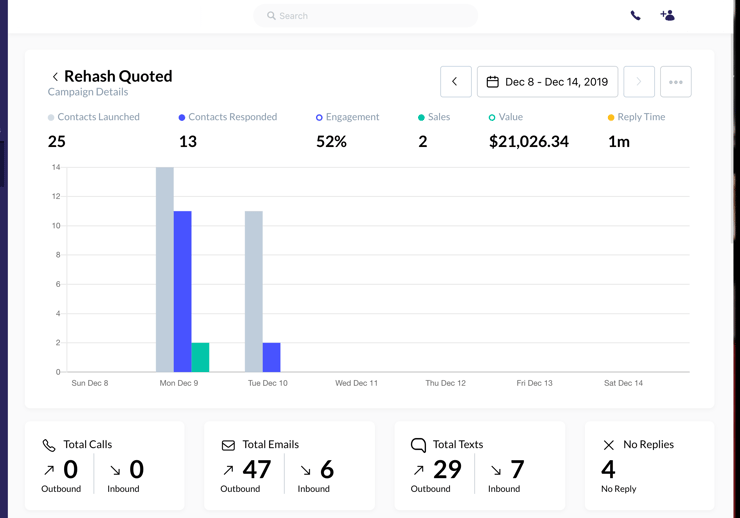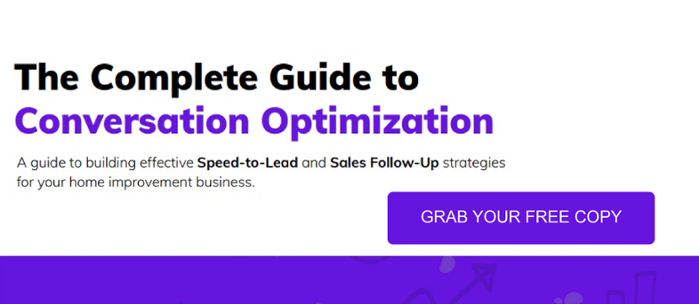Sending follow-up emails to prospects and leads can be a time-consuming task, especially when you’re a home contractor that’s great at installing roofs or replacing siding but not great at sending upwards of 30 emails a day. You do your best to find what works, what draws them in, and what seals the deal. But how much easier would it be if someone had already done the work for you and found what made the most impact?
Well, we hear you! Within the Hatch platform, our customers have sent over 1,500,000 texts and emails, making us the mortal enemy of unlimited data plans. In all seriousness, through those 1.5 million messages we've found sales follow-up cadences that work and, even more importantly, cadences that do not hit the mark.

Check out these sales follow-up cadence templates yourself below – we’ve included a little backstory on why these messages work so well, too.
Feel free to use it for your next prospect communication or make it a go-to template for your entire sales team.
High-Performing Email Marketing Templates for Home Services, Contractors, and Construction Companies
Email #1
Subject - [Company Name] Consultation | [Contact First Name] [Contact Last Name]
[Contact First Name],
My name is [Rep First Name]. I'm a [Title] with [Company]. I'm emailing you to follow-up on the recent consultation you had with us.
Would love to get your project started. When is a good time I can give you a call to get the ball rolling?
Thank you,
[Rep First Name] [Rep Last Name] | [Phone Number]
When to send: 11 am. On the same day as your initial conversation with a prospect (if no response). By sending an email early, it shows your initiative and how serious you are about being their home contractor.
Breakdown
This is the basic overall theme of the emails that generate interest - short and sweet. The more conversational the tone and style of your email is, the more authentic it feels. Authenticity is what drives response rates and will set you apart from an endless sea of spam or junk mail. And as an added bonus, your potential customer will get a feel for who you are as a business, the tone you set, and become comfortable working with you.
Just be mindful of the time and cadence of the emails you send. Following up days later can show your lead that they are not a priority, and at this point, they might have another contractor lined up. Additionally, emailing earlier in the day will put you in the front of their mind before their schedule becomes hectic, and will set the precedent that you consider them to be more valuable than a last-minute, end-of-day task.
Email #2
Subject - [Company Name] Consultation | [Contact First Name] [Contact Last Name]
[Contact First Name],
It's [Rep First Name] at [Company]. There are a few reasons why people typically don't move forward.
- Affordability
- Not enough information
- Product offering
I'm happy to work with you to better understand what it will take to earn your business. Is one of the above affecting your decision?
Thank you,
[Rep First Name] [Rep Last Name] | [Phone Number]
When to send: 11 am. Five days after initial prospect conversation (if no response).
Breakdown
We found that these are the three main areas that cause prospects to close the door to doing business with high-consideration companies. This is our favorite message in the cadence because it poses a question that creates an opportunity for conversation.
By addressing these concerns upfront, you're inviting your customer to explain why they're not doing business with you - and that gives you an opportunity to counter. Full transparency wins here. If customers feel as though you are hiding important information from them or are not willing to share the whole picture, they might decide to take their business somewhere else to a company that does have these conversations with them sooner rather than later.
Email #3
Subject - Still interested?
[Contact First Name],
It's [Rep First Name] at [Company]. I'm reaching out to see if your project is still on the table.
Thank you,
[Rep First Name] [Rep Last Name] | [Phone Number]
When to send: 11 am. Eight days after the initial prospect conversation (if no response).
Breakdown
Short and to the point. Be direct and let your customer dictate the next step. This is where you can put ownership back onto your lead or potential customer. At this point, you’ve gone above and beyond to ensure they know you are serious and willing to help them move to the next step. Don’t remove them from your radar completely, but do start stepping away to allow focus on other prospects that are ready to move forward now!
Email #4
Subject - SMOKE SIGNALS - [Contact First Name] [Contact Last Name]
[Contact First Name],
It's [Rep First Name] at [Company]. Are you looking to get this project done soon, or should I touch base in a few months?
Feel free to use me as a resource if anything comes up.
Thank you,
[Rep First Name] [Rep Last Name] | [Phone Number]
When to send: 11 am. 11 days after initial prospect conversation (if no response).
Breakdown
This is the closing email in the cadence. If you haven't heard back from your prospect over the 11 day cadence, segment them as a cold lead and make a note to follow up later with a different campaign. Cold leads are not bad leads, the timing is simply not right, and this could be for a variety of reasons. But following up again in a few months will put you back on their radar as a potential partner.
At the end of the day, just blasting automated emails alone isn't an effective strategy in today's business climate. With the focus on hyper-personalization and the demand from customers to have a tailored experience, using email templates and automated messages can be picked out of a crowd. You need the infrastructure in place for your sales team or call center to continue the conversation beyond your Gmail, Outlook, or other email services.
If you’d like additional resources to help in your follow-up process, be sure to grab a free copy of our Conversation Optimization Playbook. You’ll find actionable templates, tips, and strategies to increase your appointments set and build a better customer experience that your brand is known for.
